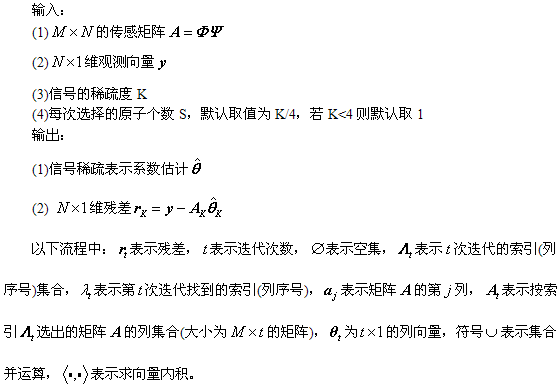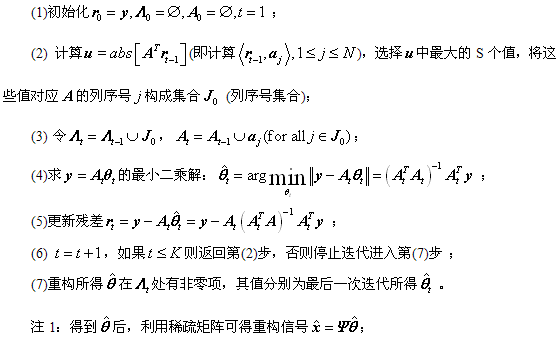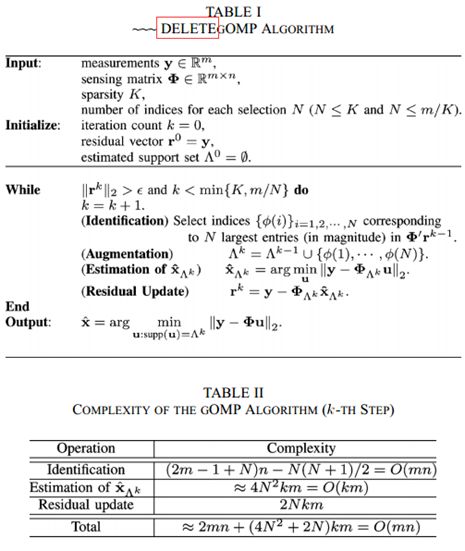浅谈压缩感知(二十八):压缩感知重构算法之广义正交匹配追踪(gOMP)
主要内容:
- gOMP的算法流程
- gOMP的MATLAB实现
- 一维信号的实验与结果
- 稀疏度K与重构成功概率关系的实验与结果
一、gOMP的算法流程
广义正交匹配追踪(Generalized OMP, gOMP)算法可以看作为OMP算法的一种推广。OMP每次只选择与残差相关最大的一个,而gOMP则是简单地选择最大的S个。之所以这里表述为"简单地选择"是相比于ROMP之类算法的,不进行任何其它处理,只是选择最大的S个而已。
gOMP的算法流程:
二、gOMP的MATLAB实现(CS_gOMP.m)
function [ theta ] = CS_gOMP( y,A,K,S ) % CS_gOMP % Detailed explanation goes here % y = Phi * x % x = Psi * theta % y = Phi*Psi * theta % 令 A = Phi*Psi, 则y=A*theta % 现在已知y和A,求theta % Reference: Jian Wang, Seokbeop Kwon, Byonghyo Shim. Generalized % orthogonal matching pursuit, IEEE Transactions on Signal Processing, % vol. 60, no. 12, pp. 6202-6216, Dec. 2012. % Available at: http://islab.snu.ac.kr/paper/tsp_gOMP.pdf if nargin < 4 S = round(max(K/4, 1)); end [y_rows,y_columns] = size(y); if y_rows<y_columns y = y';%y should be a column vector end [M,N] = size(A);%传感矩阵A为M*N矩阵 theta = zeros(N,1);%用来存储恢复的theta(列向量) Pos_theta = [];%用来迭代过程中存储A被选择的列序号 r_n = y;%初始化残差(residual)为y for ii=1:K%迭代K次,K为稀疏度 product = A'*r_n;%传感矩阵A各列与残差的内积 [val,pos]=sort(abs(product),'descend');%降序排列 Sk = union(Pos_theta,pos(1:S));%选出最大的S个 if length(Sk)==length(Pos_theta) if ii == 1 theta_ls = 0; end break; end if length(Sk)>M if ii == 1 theta_ls = 0; end break; end At = A(:,Sk);%将A的这几列组成矩阵At %y=At*theta,以下求theta的最小二乘解(Least Square) theta_ls = (At'*At)^(-1)*At'*y;%最小二乘解 %At*theta_ls是y在At)列空间上的正交投影 r_n = y - At*theta_ls;%更新残差 Pos_theta = Sk; if norm(r_n)<1e-6 break;%quit the iteration end end theta(Pos_theta)=theta_ls;%恢复出的theta end
三、一维信号的实验与结果
%压缩感知重构算法测试 clear all;close all;clc; M = 128;%观测值个数 N = 256;%信号x的长度 K = 30;%信号x的稀疏度 Index_K = randperm(N); x = zeros(N,1); x(Index_K(1:K)) = 5*randn(K,1);%x为K稀疏的,且位置是随机的 Psi = eye(N);%x本身是稀疏的,定义稀疏矩阵为单位阵x=Psi*theta Phi = randn(M,N)/sqrt(M);%测量矩阵为高斯矩阵 A = Phi * Psi;%传感矩阵 y = Phi * x;%得到观测向量y %% 恢复重构信号x tic theta = CS_gOMP( y,A,K); x_r = Psi * theta;% x=Psi * theta toc %% 绘图 figure; plot(x_r,'k.-');%绘出x的恢复信号 hold on; plot(x,'r');%绘出原信号x hold off; legend('Recovery','Original') fprintf('\n恢复残差:'); norm(x_r-x)%恢复残差
四、稀疏数K与重构成功概率关系的实验与结果
% 压缩感知重构算法测试CS_Reconstuction_KtoPercentagegOMP.m % Reference: Jian Wang, Seokbeop Kwon, Byonghyo Shim. Generalized % orthogonal matching pursuit, IEEE Transactions on Signal Processing, % vol. 60, no. 12, pp. 6202-6216, Dec. 2012. % Available at: http://islab.snu.ac.kr/paper/tsp_gOMP.pdf clear all;close all;clc; addpath(genpath('../../OMP/')) %% 参数配置初始化 CNT = 1000; %对于每组(K,M,N),重复迭代次数 N = 256; %信号x的长度 Psi = eye(N); %x本身是稀疏的,定义稀疏矩阵为单位阵x=Psi*theta M_set = [128]; %测量值集合 KIND = ['OMP ';'ROMP ';'StOMP ';'SP ';'CoSaMP ';... 'gOMP(s=3)';'gOMP(s=6)';'gOMP(s=9)']; Percentage = zeros(N,length(M_set),size(KIND,1)); %存储恢复成功概率 %% 主循环,遍历每组(K,M,N) tic for mm = 1:length(M_set) M = M_set(mm); %本次测量值个数 K_set = 5:5:70; %信号x的稀疏度K没必要全部遍历,每隔5测试一个就可以了 %存储此测量值M下不同K的恢复成功概率 PercentageM = zeros(size(KIND,1),length(K_set)); for kk = 1:length(K_set) K = K_set(kk); %本次信号x的稀疏度K P = zeros(1,size(KIND,1)); fprintf('M=%d,K=%d\n',M,K); for cnt = 1:CNT %每个观测值个数均运行CNT次 Index_K = randperm(N); x = zeros(N,1); x(Index_K(1:K)) = 5*randn(K,1); %x为K稀疏的,且位置是随机的 Phi = randn(M,N)/sqrt(M); %测量矩阵为高斯矩阵 A = Phi * Psi; %传感矩阵 y = Phi * x; %得到观测向量y %(1)OMP theta = CS_OMP(y,A,K); %恢复重构信号theta x_r = Psi * theta; % x=Psi * theta if norm(x_r-x)<1e-6 %如果残差小于1e-6则认为恢复成功 P(1) = P(1) + 1; end %(2)ROMP theta = CS_ROMP(y,A,K); %恢复重构信号theta x_r = Psi * theta; % x=Psi * theta if norm(x_r-x)<1e-6 %如果残差小于1e-6则认为恢复成功 P(2) = P(2) + 1; end %(3)StOMP theta = CS_StOMP(y,A); %恢复重构信号theta x_r = Psi * theta; % x=Psi * theta if norm(x_r-x)<1e-6 %如果残差小于1e-6则认为恢复成功 P(3) = P(3) + 1; end %(4)SP theta = CS_SP(y,A,K); %恢复重构信号theta x_r = Psi * theta; % x=Psi * theta if norm(x_r-x)<1e-6 %如果残差小于1e-6则认为恢复成功 P(4) = P(4) + 1; end %(5)CoSaMP theta = CS_CoSaMP(y,A,K); %恢复重构信号theta x_r = Psi * theta; % x=Psi * theta if norm(x_r-x)<1e-6 %如果残差小于1e-6则认为恢复成功 P(5) = P(5) + 1; end %(6)gOMP,S=3 theta = CS_gOMP(y,A,K,3); %恢复重构信号theta x_r = Psi * theta; % x=Psi * theta if norm(x_r-x)<1e-6 %如果残差小于1e-6则认为恢复成功 P(6) = P(6) + 1; end %(7)gOMP,S=6 theta = CS_gOMP(y,A,K,6); %恢复重构信号theta x_r = Psi * theta; % x=Psi * theta if norm(x_r-x)<1e-6 %如果残差小于1e-6则认为恢复成功 P(7) = P(7) + 1; end %(8)gOMP,S=9 theta = CS_gOMP(y,A,K,9); %恢复重构信号theta x_r = Psi * theta; % x=Psi * theta if norm(x_r-x)<1e-6 %如果残差小于1e-6则认为恢复成功 P(8) = P(8) + 1; end end for iii = 1:size(KIND,1) PercentageM(iii,kk) = P(iii)/CNT*100; %计算恢复概率 end end for jjj = 1:size(KIND,1) Percentage(1:length(K_set),mm,jjj) = PercentageM(jjj,:); end end toc save KtoPercentage1000gOMP %运行一次不容易,把变量全部存储下来 %% 绘图 S = ['-ks';'-ko';'-yd';'-gv';'-b*';'-r.';'-rx';'-r+']; figure; for mm = 1:length(M_set) M = M_set(mm); K_set = 5:5:70; L_Kset = length(K_set); for ii = 1:size(KIND,1) plot(K_set,Percentage(1:L_Kset,mm,ii),S(ii,:)); %绘出x的恢复信号 hold on; end end hold off; xlim([5 70]); legend('OMP','ROMP','StOMP','SP','CoSaMP',... 'gOMP(s=3)','gOMP(s=6)','gOMP(s=9)'); xlabel('Sparsity level K'); ylabel('The Probability of Exact Reconstruction'); title('Prob. of exact recovery vs. the signal sparsity K(M=128,N=256)(Gaussian)');
结论:gOMP只是在OMP基础上修改了一下原子选择的个数,效果就好很多。
六、参考文章
http://blog.csdn.net/jbb0523/article/details/45693027




